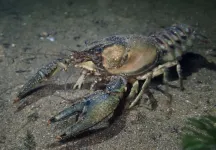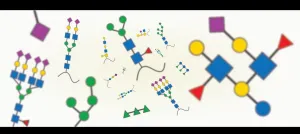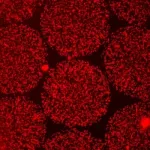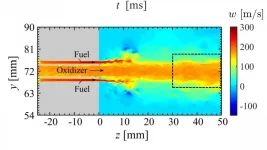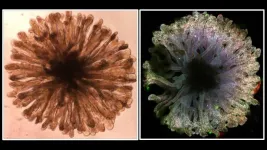(Press-News.org) Pharmaceutical pollution is found in streams and rivers globally, but little is known about its effects on animals and ecosystems. A new study, published in the journal Ecosphere, investigated the effects of antidepressant pollution on crayfish. Just two weeks of citalopram exposure caused changes in crayfish behavior, with the potential to disrupt stream ecosystem processes like nutrient cycling, oxygen levels, and algal growth.
Coauthor Emma Rosi, a freshwater ecologist at Cary Institute of Ecosystem Studies, says, "Animals living in streams and rivers are exposed to a chronic mix of pharmaceutical pollution as a result of wastewater contamination. Our study explored how antidepressant levels commonly found in streams impact crayfish, and how these changes reverberate through stream ecosystems."
Crayfish are a keystone species in streams, where they eat invertebrates, break down leaf litter, and cycle nutrients. They are stress-tolerant and can become abundant in urban waterways. These freshwaters are prone to receiving pharmaceutical pollution from sewer overflows, leaky septic tanks, and treated wastewater effluent that contains pharmaceuticals.
Lead author Alexander Reisinger, an Assistant Professor at University of Florida, Gainesville, says, "Previous research via direct injection found that antidepressants alter serotonin and aggression in crustaceans. Our study found that exposure to low doses of citalopram - at levels currently found in urban streams as a result of pollution - is enough to alter crayfish behaviors like foraging, aggression, and shelter use."
Cary Institute's artificial stream facility was used to test effects of citalopram on crayfish and stream ecosystems. Twenty stream habitats were created with low-nutrient groundwater and quartz rocks and red maple leaf packs that had been colonized with microbes, invertebrates, and algae. Streams were randomly selected to receive one of four treatments: no citalopram + no crayfish, citalopram + no crayfish, crayfish + no citalopram, and citalopram + crayfish. Each treatment was applied to five streams. Three male crayfish were added to each of the 'crayfish' streams.
For two weeks, the team dosed the 10 streams receiving citalopram every other day to mimic low, persistent pharmaceutical pollution found in urban streams. Over the course of the experiment, they monitored indicators that would reveal changes in stream ecosystem functioning, such as dissolved oxygen, temperature, light penetration, and algae. At the end of the two weeks, the behavior of exposed and non-exposed crayfish was tested.
To do this, the team tapped into crayfish's keen sense of smell. They used a tank containing a shelter at one end and a divider down the middle. One side of the tank contained water that had passed by sardine gelatin; the other contained water that had passed by another male crayfish. One at a time, they placed the crayfish in the shelter, then recorded the amount of time it took for each to peek out of the shelter and emerge completely. They also recorded the amount of time spent in the sardine and crayfish signal sides of the tank.
Crayfish exposed to citalopram emerged from the shelter sooner, indicating increased 'boldness'. Exposed crayfish were also more interested in food, lingering in the food-scented area over 3x longer than the crayfish-scented area. Crayfish that were not exposed to citalopram took longer to emerge and divided their time equally between the food and crayfish areas, showing no preference.
Reisinger explains, "Citalopram-exposed crayfish are more attracted to food, and less interested in other crayfish. Less time spent hiding and more time foraging could make crayfish more vulnerable to predators, meaning more get eaten. We would expect increased crayfish foraging to lead to higher rates of leaf litter decomposition and biofilm turnover, altering in-steam nutrient flows. Either of these changes could have cascading effects."
In people, 'metabolism' refers to a collection of chemical processes that regulate bodily functions essential to health like breathing, digestion, and temperature regulation. Stream 'metabolism' includes a variety of indicators like oxygen levels, light penetration, and nutrient cycling, which together shape stream health.
The team used their two-week record of stream indicators to assess changes in the metabolism of each stream. They found that crayfish presence versus absence significantly affects stream metabolism. Effects of citalopram alone were not significant, but results suggest that changes in stream functioning would likely occur over time due to citalopram's effects on crayfish behavior.
Reisinger explains, "With just two weeks of citalopram exposure, we saw marked changes in crayfish behavior. Over months to years, we would expect these changes to magnify. Fewer crayfish could reduce populations of the fish that eat them like trout, bass, and catfish. Changes in algal growth or turnover would alter oxygen levels and nutrient dynamics - key aspects of stream functioning that could cause harmful imbalances in the system."
Rosi concludes, "Toxicity assessments of pharmaceuticals often focus on lethal effects, but it is clear that these drugs can affect non-target organisms without killing them and behavioral changes can have ecological consequences. More work is needed to understand how pharmaceutical pollution impacts stream life at chronic, sublethal levels, and what these changes mean for freshwater quality, ecosystem health, and foodwebs - in streams and beyond."
INFORMATION:
Investigators
Alexander Reisinger - University of Florida, Soil and Water Sciences Department
Lindsey Reisinger - University of Florida, Fisheries and Aquatic Sciences Program
Erinn Richmond - Monash University, Water Studies Center, School of Chemistry
Emma Rosi - Cary Institute of Ecosystem Studies
Cary Institute of Ecosystem Studies is an independent nonprofit center for environmental research. Since 1983, our scientists have been investigating the complex interactions that govern the natural world and the impacts of climate change on these systems. Our findings lead to more effective management and policy actions and increased environmental literacy. Staff are global experts in the ecology of: cities, disease, forests, and freshwater.
New Haven, Conn. --In a new study led by Yale Cancer Center, researchers show the nucleoside transporter ENT2 may offer an unexpected path to circumventing the blood-brain barrier (BBB) and enabling targeted treatment of brain tumors with a cell-penetrating anti-DNA autoantibody. The study was published today online in the Journal of Clinical Investigation Insight.
"These findings are very encouraging as the BBB prevents most antibodies from penetrating the central nervous system and limits conventional antibody-based approaches to brain tumors," said James E. Hansen, MD, associate professor of therapeutic radiology, radiation oncology chief of the Yale Gamma Knife Center at Smilow Cancer Hospital, and corresponding author of the study.
Deoxymab-1 (DX1) ...
Ethiopia, Nigeria, Colombia, Myanmar and Syria are just a handful of the places around the world currently engaged in ongoing civil wars. Even when peace agreements can be negotiated to end civil wars, maintaining stability is incredibly challenging. In these fragile post-conflict areas, a small communal dispute can easily escalate and unravel peace deals.
Peacekeepers can help contain the spread of violence and promote peaceful interactions between groups, but how? And in what situations can peacekeepers be most effective? New research from Washington University ...
Changing your eating habits or altering your circadian clock can impact healthy fat tissue throughout your lifespan, according to a preclinical study published today in Nature by researchers with The University of Texas Health Science Center at Houston (UTHealth).
Healthy fat tissue helps provide energy, supports cell growth, protects organs, and keeps the body warm. A good quality diet and one that is consumed in a rhythmic manner (i.e., during our active cycle) is important in maintaining healthy fat, the researchers found.
Adipocyte progenitor cells mature into adipocytes - the healthy fat cells that make up our adipose tissue, which stores energy as fat. Researchers discovered that adipocyte progenitors undergo rhythmic daily proliferation throughout the ...
A new model that applies artificial intelligence to carbohydrates improves the understanding of the infection process and could help predict which viruses are likely to spread from animals to humans. This is reported in a recent study led by researchers at the University of Gothenburg.
Carbohydrates participate in nearly all biological processes - yet they are still not well understood. Referred to as glycans, these carbohydrates are crucial to making our body work the way it is supposed to. However, with a frightening frequency, they are also ...
Researchers at the University of Maryland School of Medicine (UMSOM) have developed two rapid diagnostic tests for COVID-19 that are nearly as accurate as the gold-standard test currently used in laboratories. Unlike the gold standard test, which extracts RNA and uses it to amplify the DNA of the virus, these new tests can detect the presence of the virus in as little as five minutes using different methods.
One test is a COVID-19 molecular diagnostic test, called Antisense, that uses electrochemical sensing to detect the presence of the virus. The other uses a simple assay of gold nanoparticles to detect a color change when the virus is present. Both tests were developed by Dipanjan Pan, PhD, Professor of Diagnostic Radiology and Nuclear Medicine ...
Two new studies have cast unprecedented light on disease processes in tuberculosis, identifying key genetic changes that cause damage in the lungs and a drug treatment that could speed up recovery.
Tuberculosis (TB) is a lung infection that has killed more humans than any other and until last year was the top infectious killer around the world. Globally, an estimated 10 million people develop the disease each year.
The findings are reported in two papers in the Journal of Clinical Investigation.
In the first study, a team from the University of Southampton used a new 3D culture system they have developed to observe the changes that occur in cells infected with TB. Unlike the laboratory-standard 2D culture system, where cells are placed ...
This past year has been transformational in terms of not only a global pandemic but a sustained focus on racism and systemic injustice. There has been a widespread circulation of images and videos in the news and online. Just like adults, adolescents are exposed to these images with important consequences for their emotional health and coping. However, few studies have sought to understand the influence of racism experienced online.
According to a qualitative study published in JAMA Network Open adolescents expressed feelings of helplessness when exposed to secondhand racism online. Specifically, adolescents described helplessness stemming from the pervasiveness of racism in our society. This was illustrated by quotes, such as "[racist events are] just another day in the life" referring ...
WASHINGTON, June 8, 2021 -- Combustion engines can develop high frequency oscillations, leading to structural damage to the engines and unsafe operating conditions. A detailed understanding of the physical mechanism that causes these oscillations is required but has been lacking until now.
In Physics of Fluids, by AIP Publishing, research from the Tokyo University of Science and the Japan Aerospace Exploration Agency clarifies the feedback processes that give rise to these oscillations in rocket engines.
The investigators studied simulated combustion events in a computational model of a rocket combustor. Their analysis involved sophisticated techniques, including symbolic ...
For many, the Thale cress (Arabidopsis thaliana) is little more than a roadside weed, but this plant has a long history with scientists trying to understand how plants grow and develop. Arabidopsis was first scientifically described as early as the 16th century and the first genetic mutant was identified in the 1800s. Since the 1940s, Arabidopsis has increased in popularity within the scientific community, which continues to use it as a model system to explore plant genetics, development and physiology to this day.
One might expect that after decades of scientific scrutiny the structure of Arabidopsis had been fully documented, but a new study from scientists from The Pennsylvania State University, USA, has revealed that this humble plant still has some surprises. The researchers describe ...
A team of scientists at the Keck School of Medicine of USC has created what could be a key building block for assembling a synthetic kidney. In a new study in Nature Communications, Zhongwei Li and his colleagues describe how they can generate rudimentary kidney structures, known as organoids, that resemble the collecting duct system that helps maintain the body's fluid and pH balance by concentrating and transporting urine.
"Our progress in creating new types of kidney organoids provides powerful tools for not only understanding development and disease, but also finding new treatments and regenerative approaches for patients," said Li, the study's corresponding ...
